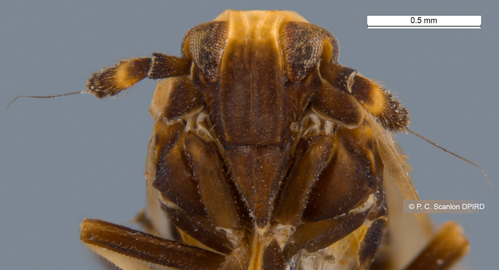Peregrinus maidis (Ashmead)
Maize planthopper
Caution
Many of the insects depicted on these pages are outwardly similar and you should not use photographs as the sole means of identification. These pages form part of a scientific key which will assist a trained entomologist to identify the species accurately.
Peregrinus maidis (Ashmead, 1890)
Common Name: Maize planthopper, Corn planthopper
Subfamily/Tribe: Delphacinae: Delphacini
Distribution: A cosmopolitan species that occurs in most countries with tropical, subtropical and Mediterranean climates (basically wherever corn is grown) (CABI 2018). Within Australia it has been recorded from Qld, NSW, NT, WA and SA.
Economic Status: Host plants of Peregrinus maidis include maize (corn), sorghum, rice, sugarcane and a number of other grasses (Poaceae) (Singh & Seetharama 2008). The preferred hosts are corn and sorghum, on which Peregrinus maidis populations become so abundant that the high amounts of honeydew produced results in sooty mould outbreaks and stunting of plant growth (Plantwise 2018). Peregrinus maidis is a vector of Finger millet mosaic virus, Iranian maize mosaic virus, Maize sterile stunt virus, Maize stripe virus (Bartlett 2018) and Sorghum stripe virus, an isolate of maize stripe virus on sorghum (Narayana & Muniyappa 1996). Maize stripe virus and Maize sterile stunt virus are present in Australia (Greber 1982; Gingery 1985), but the other viruses are not.
Notes: Despite being a cosmopolitan pest, P. maidis may be native to Australia or the Oceania region (Singh & Seetharama 2008). It is the only representative of Peregrinus present in Australia, with a second species restricted to Africa (Bartlett 2018). Peregrinus maidis can be brachypterous or macropterous, but winged individuals are relatively easy to distinguish from other Delphacidae with the distinctive frons colouring and patterns on the wings.
© US Department of Agriculture [wikipedia creative commons] |
 |
 |

